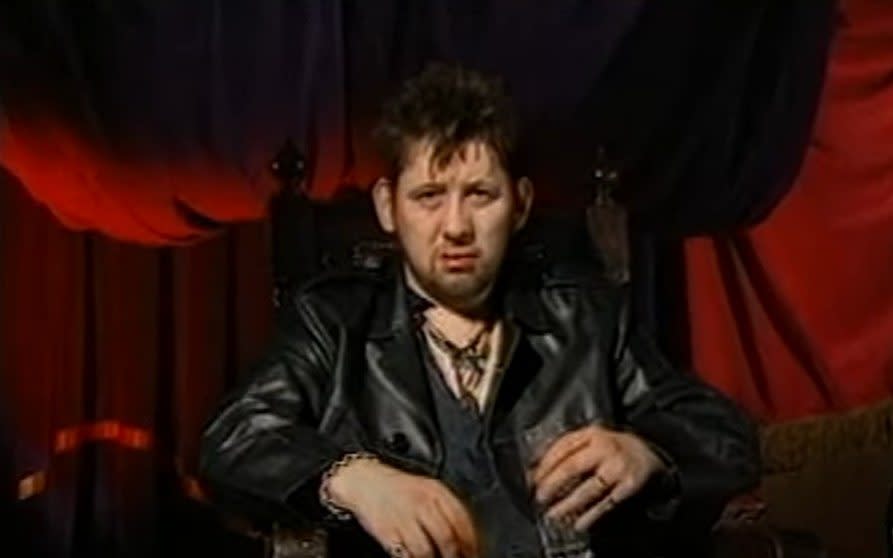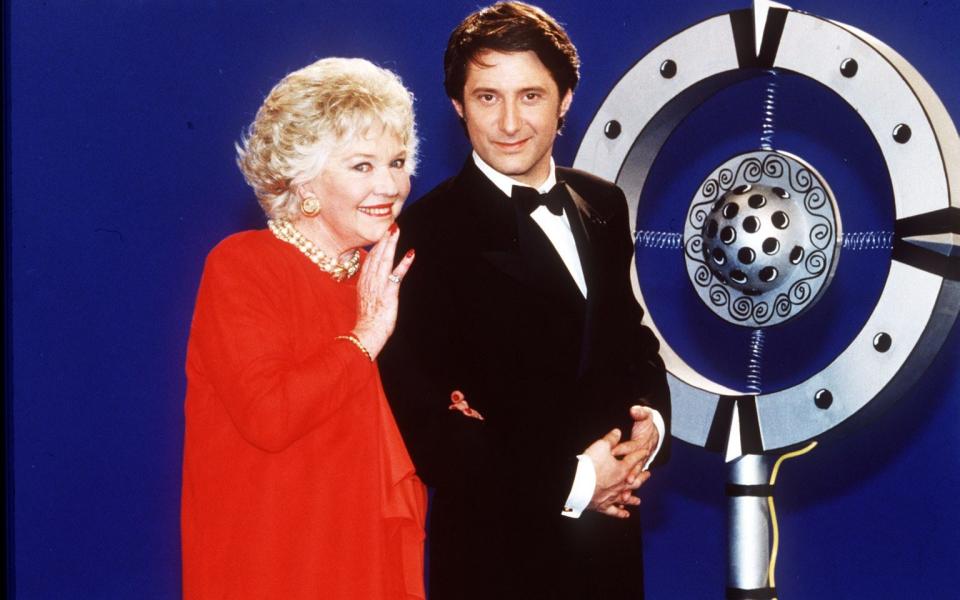‘Shane MacGowan insisted I Nazi salute him’: behind the scenes of A Song for Eurotrash

In the mid-1990s, a young music producer named Nick Bradshaw sat in a bar with his friend, The Specials’ Terry Hall, discussing a bizarre brainwave he’d had involving enlisting credible artists to cover Eurovision winners. “When Terry smiled, not something he is renowned for, I knew this idea actually stood a chance of getting somewhere,” recalled Bradshaw in 1998.
The result was Channel 4’s largely forgotten A Song for Eurotrash: where Eurotrash, Rapido Television’s late night entertainment show created by Peter Stuart, hosted an anarchic alternative song contest. When Bradshaw pitched the idea to Stuart, Stuart considered it too ambitious. “I was embarrassed that I hadn’t thought of it before, because Eurotrash and Eurovision inhabit the same kitsch universe,” Stuart says. “Though I thought it was a wonderful idea, I was convinced it would never happen.”
And yet, on May 2 1998, a couple of weeks after the UK’s entry Imaani Saleem finished a respectable second for Where Are You?, A Song for Eurotrash unfolded like a fever dream. It saw Hall and Sinéad O’Connor duet on a surprisingly poignant version of Dana’s 1970 winner for Ireland All Kinds of Everything, Shane MacGowan and The Popes leaning into the existential angst of Johnny Logan’s What’s Another Year, and Bananarama reuniting with original member Siobhan Fahey for the first time in a decade with a raucous tribute to Abba’s Waterloo, replete with backing dancers dressed as Napoleons.
What’s more, former Orange Juice frontman Edwyn Collins transformed the 1975 Netherlands winner, Teach-In’s inane Ding-A-Dong, into a lush Wigan Casino soul track, while acid house pioneers 808 State reworked The Prelude to Charpentier’s Te Deum, which has heraldically opened Eurovision for over 60 years.
Behind the scenes, things were equally surreal. Eurotrash director Rik Lander was tasked with shooting the video for Shane MacGowan and The Popes’ weather-beaten rendition of What’s Another Year, where the late singer is cast as a king-like figure, presented with an assortment of acts (balloon animal-modellers, burlesque dancers) to entertain him, which he summarily dismisses.
“He was drinking whisky and presumably on heroin, so he sat on the throne and dozed off, even during takes, as you can see in the video,” recalls Lander. “But when he was awake, he was so bright and switched on.” Lander fondly describes MacGowan as “good value”, although he initially tested the director to see if he had the required skills to deal with him. “Out of nowhere, Shane said: ‘We supported the other side in the Second World War’. He was referring to Irish Republicans, and he said: ‘I will only follow your cues if you Nazi salute each time you want me to do it.’
“Each time I needed him to do the action, I had to jump up and put my finger on my top lip with the other arm flung out in order for him to take the cue!” At one point, the video required MacGowan to have an argument with a bishop. “Shane said: ‘He’s wearing purple. He can’t be a bishop’, and then proceeded to tell me what all the colours of the hierarchy of the Catholic Church were,” laughs Lander.
Despite the excess, sieg-heils and religious sermons, Lander recalls MacGowan’s touching appreciation for the source material. “He was a Eurovision fan and loved Johnny Logan, who had won Eurovision multiple times for Ireland. He recognised the beauty of the song and was keen to emphasise that it was an unusual winner because it has such miserable lyrics, and he turned it into a tragic ‘what’s the point of life?’ dirge.

Hall and O’Connor’s duet on All Kinds of Everything transformed Dana’s saccharine original into a haunting tale of two wounded souls finding comfort in each other. Recorded in The Church Studios in North London – with the video shot there on the same afternoon – its owner, Eurythmic Dave Stewart, dropped by to provide the guitar track uncredited, according to Bradshaw. “It’s my favourite reworking,” praises Stuart. “There’s something I find so charming about the video and the warmth that comes through in their close-ups. All of the artists liked the original songs. They weren’t doing it purely as pastiche or tongue-in-cheek, and that sense comes through with Terry Hall and Sinéad O’Connor; you can feel the love for the original material from them.”
Joining saucy Eurotrash stalwart Antoine de Caunes as co-anchor was then-71-year-old polyglot Queen of Eurovision Katie Boyle, who had hosted the contest four times, and added a regal galleon to proceedings while gamely camping it up to the nines. She waxed nostalgically about presenting in 1974 sans underwear and delivered an innuendo-ridden scripted sexual fantasy involving Bj?rn Ulvaeus, Benny Andersson and IKEA with a gusto.
“Her and Antoine made for a strangely flirtatious team,” says Stuart. “She brought an elegance and sophistication to the show that it had not always had, but even I was surprised at how far she was willing to go! Something would happen on that Eurotrash set where people would go further than they would in any other circumstance. That’s how we managed to get Carla Bruni to talk about sex acts in different languages in 1996 – which French president Nicolas Sarkozy, who she later married, was not happy about!”
Others didn’t have such a natural Duolingo bird-rivalling aptitude for languages. Arguably no band on A Song for Eurotrash had a tougher task than indie-outfit Dubstar, who opened and closed the show in the studio by performing Luxembourg’s 1965 victor, France Gall’s Poupée de Cire, Poupée de Son, in French alongside Gallic crooner Sacha Distel. It was an odd pairing – Dubstar being known for Not So Manic Now, about sexual assault in a tower block, paired with Granny’s favourite Raindrops Keep Falling on My Head singer.
Dubstar frontwoman Sarah Blackwood found learning the Serge Gainsbourg-penned lyrics (which subversively suggested that singers were little more than plastic product) taxing and “got trollied the night before” to deal with nerves and imposter syndrome. “The cameramen knew I was feeling rancid and found it hilarious to turn off the autocue during my close-ups so I was left gasping like a goldfish, looking like John Redwood trying to do the National Anthem!,” she laughs. “I remember Sacha asking: ‘Which tie shall I wear?’, holding up spots and stripes while I’m desperately trying not to vomit over him.”
Nevertheless, Dubstar enthuse that Distell was charm personified, and he gifted them a guitar-plectrum he always carried around in his pocket. “He told me: ‘Your French accent is better than my good friend Dionne Warwick’s!’” says Blackwood. In a snapshot of Nineties raunch TV, guitarist Chris Wilkie notes that the Eurotrash dancers were constantly naked backstage. “I was getting my make-up done with Sacha while he explained that he liked to take his time because he’d had skin cancer. As he was soberly telling me his history with the disease – which unfortunately would claim his life six years after we recorded the show – all these topless women were bouncing playfully around us. It was a bizarre juxtaposition.”
At the end of the evening, as with the real Eurovision, the audience could vote for a winner – an accolade scooped by Bananarama’s Waterloo. After not speaking for seven years, members Sara Dallin and Keren Woodward reunited with Fahey, who had exited in 1988 and later formed Shakespears Sister, for a one-off because it would be a laugh. “They sat in the green room and got pissed,” says Lander, who directed the video. “They were having fun because all the bad stuff was forgotten, so they’d come out, film a shot, and then return to drinking.” Filming had to be stopped during a climatic food fight when Dallin injured one of the dancers by hurling a can of whipped cream at his bicorne-clad head.
Despite the pedigree of talent involved, A Song for Eurotrash (which was broadcast twice, on May 2 and May 12 1988) remains relegated to grainy YouTube rips, while the attendant CD compilation is out of print. And, while some of the Nineties hallmarks of Eurotrash would seem politically incorrect today, there’s a joy in seeing an unlikely In Memoriam’s worth of musicians (Hall passed away in 2022, O’Connor and both MacGowan died a year later) joyously treating Eurovision with reverential disrespect. Could it be done today?
“I’d hope so,” says Lander. “The fact that it’s Eurotrash set the tone, and you’re starting to see flashbacks to its sense of danger and irreverence in Late Night Lycett, so I’d love to see it happen again.”
The second Eurovision semi-final is broadcast on May 9, 8pm, BBC One; the final is on May 11, 8pm
